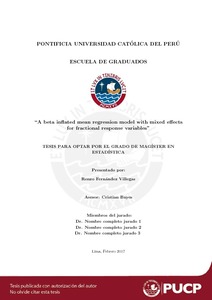| dc.contributor.advisor | Bayes Rodríguez, Cristian Luis | es_ES |
| dc.contributor.author | Fernández Villegas, Renzo | es_ES |
| dc.date.accessioned | 2017-06-20T17:26:19Z | es_ES |
| dc.date.available | 2017-06-20T17:26:19Z | es_ES |
| dc.date.created | 2017 | es_ES |
| dc.date.issued | 2017-06-20 | es_ES |
| dc.identifier.uri | http://hdl.handle.net/20.500.12404/8847 | |
| dc.description.abstract | In this article we propose a new mixed effects regression model for fractional bounded response variables. Our model allows us to incorporate covariates directly to the expected
value, so we can quantify exactly the influence of these covariates in the mean of the variable of interest rather than to the conditional mean. Estimation is carried out from a Bayesian perspective and due to the complexity of the augmented posterior distribution we use a Hamiltonian Monte Carlo algorithm, the No-U-Turn sampler, implemented using Stan software. A simulation study for comparison, in terms of bias and RMSE, was performed showing that our model has a better performance than other traditional longitudinal models for bounded variables. Finally, we applied our Beta Inflated mixed-effects regression model to real data which consists of utilization of credit lines in the peruvian financial system. | es_ES |
| dc.description.abstract | En este artículo proponemos un nuevo modelo de regresión con efectos mixtos para variables acotadas fraccionarias. Este modelo nos permite incorporar covariables directamente al valor esperado, de manera que podemos cuantificar exactamente la influencia de estas covariables en la media de la variable de interés en vez de en la media condicional. La estimación se llevó a cabo desde una perspectiva bayesiana y debido a la complejidad de la distribución aumentada a posteriori usamos un algoritmo de Monte Carlo Hamiltoniano, el muestreador No-U-Turn, que se encuentra implementado en el software Stan. Se realizó un estudio de simulación que compara, en términos de sesgo y RMSE, el modelo propuesto con otros modelos tradicionales longitudinales para variables acotadas, resultando que el primero tiene un mejor desempeño. Finalmente, aplicamos nuestro modelo de regresión Beta Inflacionada con efectos mixtos a datos reales los cuales consistían en información de la utilización de las líneas de crédito en el sistema financiero peruano. | es_ES |
| dc.language.iso | eng | es_ES |
| dc.publisher | Pontificia Universidad Católica del Perú | es_ES |
| dc.rights | info:eu-repo/semantics/openAccess | es_ES |
| dc.rights.uri | http://creativecommons.org/licenses/by-nc-nd/2.5/pe/ | * |
| dc.subject | Estadística bayesiana | es_ES |
| dc.subject | Análisis de regresión | es_ES |
| dc.subject | Estadística--Modelos matemáticos | es_ES |
| dc.title | A beta inflated mean regression model with mixed effects for fractional response variables | es_ES |
| dc.type | info:eu-repo/semantics/masterThesis | es_ES |
| thesis.degree.name | Maestro en Estadística | es_ES |
| thesis.degree.level | Maestría | es_ES |
| thesis.degree.grantor | Pontificia Universidad Católica del Perú. Escuela de Posgrado | es_ES |
| thesis.degree.discipline | Estadística | es_ES |
| renati.advisor.dni | 40372640 | |
| renati.advisor.orcid | https://orcid.org/0000-0003-0474-7921 | es_ES |
| renati.discipline | 542037 | es_ES |
| renati.level | https://purl.org/pe-repo/renati/level#maestro | es_ES |
| renati.type | http://purl.org/pe-repo/renati/type#tesis | es_ES |
| dc.publisher.country | PE | es_ES |
| dc.subject.ocde | https://purl.org/pe-repo/ocde/ford#1.01.03 | es_ES |






